通用版小升初英语语法突破荟萃集训专题十二 情态动词课件(共20张PPT)
文档属性
| 名称 | 通用版小升初英语语法突破荟萃集训专题十二 情态动词课件(共20张PPT) | 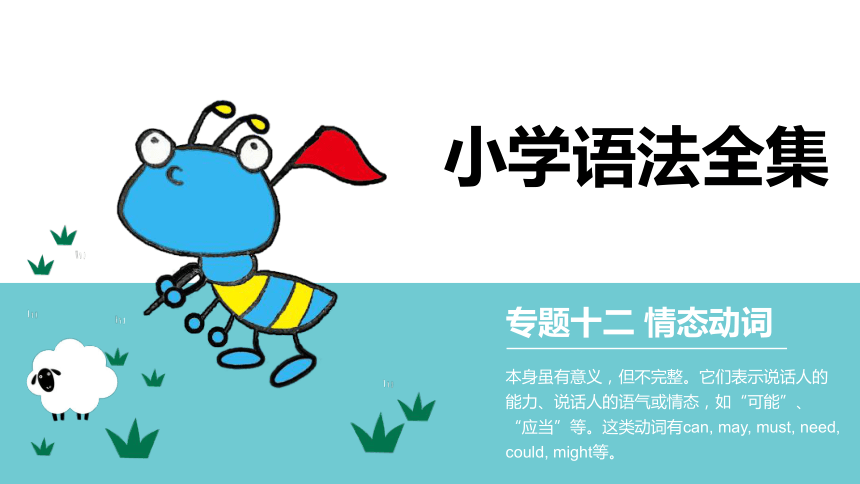 | |
| 格式 | zip | ||
| 文件大小 | 737.6KB | ||
| 资源类型 | 试卷 | ||
| 版本资源 | 人教(新起点) | ||
| 科目 | 英语 | ||
| 更新时间 | 2022-06-30 09:36:56 | ||
图片预览

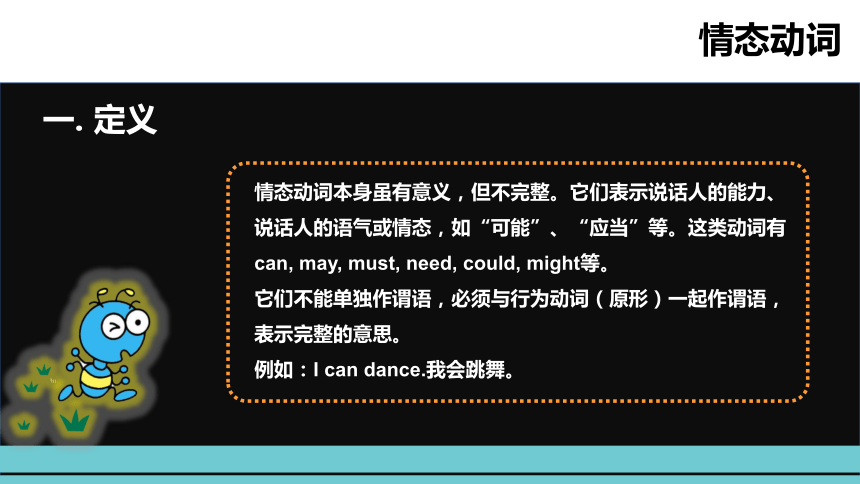
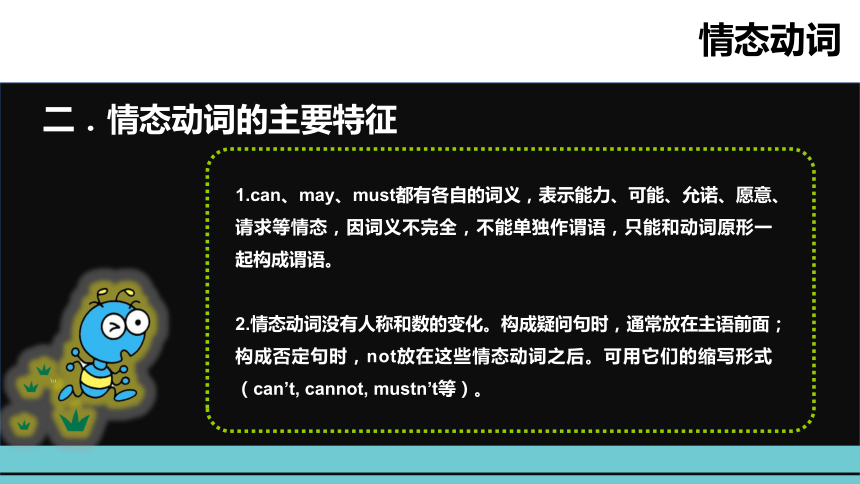
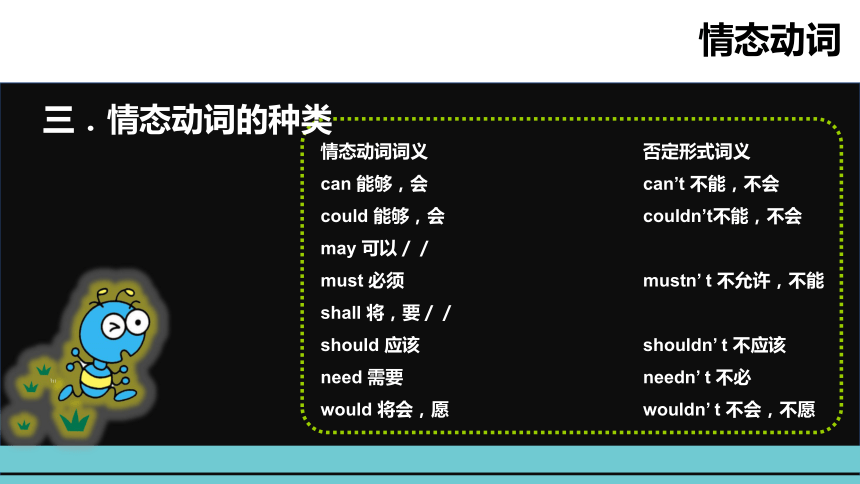
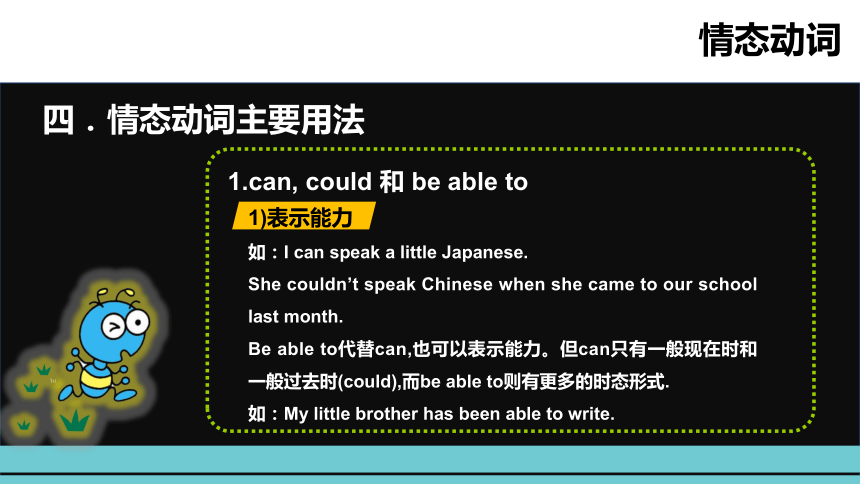
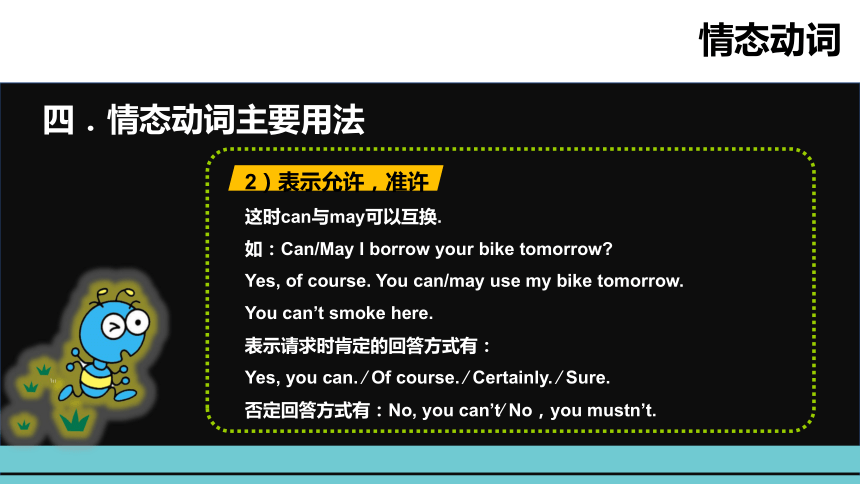
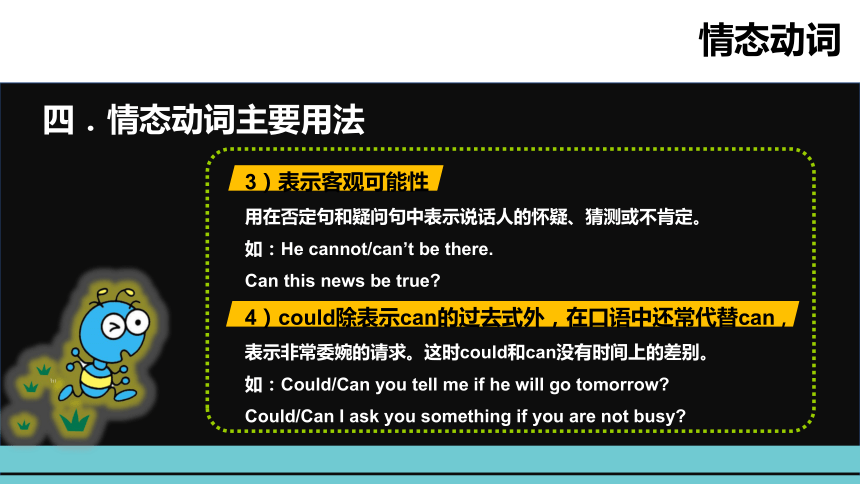
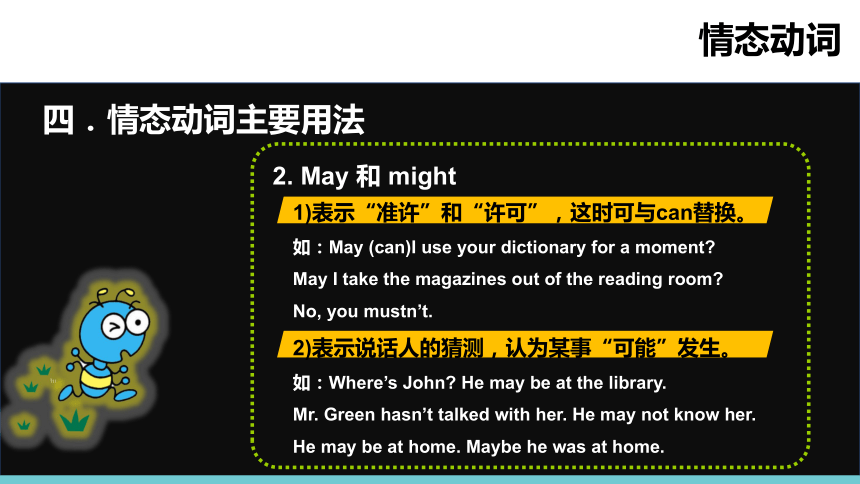
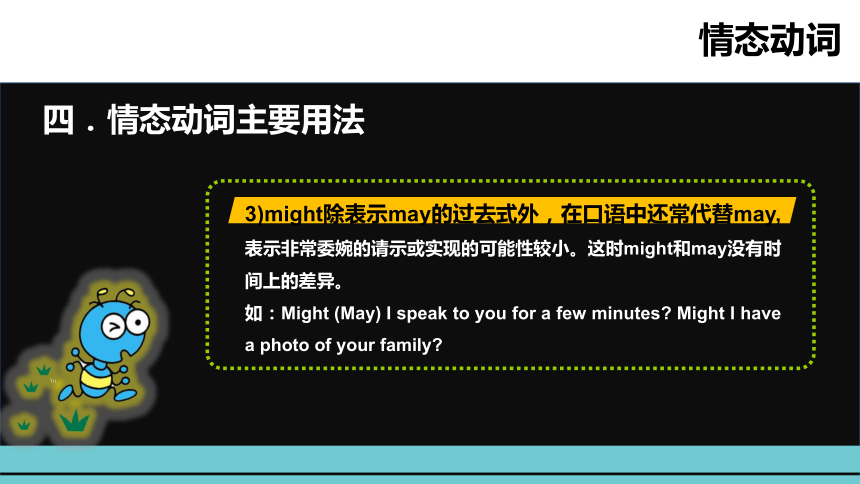
文档简介
(共20张PPT)
小学语法全集
专题十二 情态动词
本身虽有意义,但不完整。它们表示说话人的能力、说话人的语气或情态,如“可能”、“应当”等。这类动词有can, may, must, need, could, might等。
情态动词
一. 定义
情态动词本身虽有意义,但不完整。它们表示说话人的能力、说话人的语气或情态,如“可能”、“应当”等。这类动词有can, may, must, need, could, might等。
它们不能单独作谓语,必须与行为动词(原形)一起作谓语,表示完整的意思。
例如:I can dance.我会跳舞。
二.情态动词的主要特征
情态动词
1.can、may、must都有各自的词义,表示能力、可能、允诺、愿意、请求等情态,因词义不完全,不能单独作谓语,只能和动词原形一起构成谓语。
2.情态动词没有人称和数的变化。构成疑问句时,通常放在主语前面;构成否定句时,not放在这些情态动词之后。可用它们的缩写形式(can’t, cannot, mustn’t等)。
情态动词
情态动词词义 否定形式词义
can 能够,会 can’t 不能,不会
could 能够,会 couldn’t不能,不会
may 可以//
must 必须 mustn’ t 不允许,不能
shall 将,要//
should 应该 shouldn’ t 不应该
need 需要 needn’ t 不必
would 将会,愿 wouldn’ t 不会,不愿
三.情态动词的种类
四.情态动词主要用法
情态动词
1)表示能力
如:I can speak a little Japanese.
She couldn’t speak Chinese when she came to our school last month.
Be able to代替can,也可以表示能力。但can只有一般现在时和一般过去时(could),而be able to则有更多的时态形式.
如:My little brother has been able to write.
1.can, could 和 be able to
四.情态动词主要用法
情态动词
2)表示允许,准许
这时can与may可以互换.
如:Can/May I borrow your bike tomorrow
Yes, of course. You can/may use my bike tomorrow.
You can’t smoke here.
表示请求时肯定的回答方式有:
Yes, you can. ∕ Of course. ∕ Certainly. ∕ Sure.
否定回答方式有:No, you can’t∕ No,you mustn’t.
四.情态动词主要用法
情态动词
3)表示客观可能性
用在否定句和疑问句中表示说话人的怀疑、猜测或不肯定。
如:He cannot/can’t be there.
Can this news be true
4)could除表示can的过去式外,在口语中还常代替can,表示非常委婉的请求。这时could和can没有时间上的差别。
如:Could/Can you tell me if he will go tomorrow
Could/Can I ask you something if you are not busy
四.情态动词主要用法
情态动词
2. May 和 might
1)表示“准许”和“许可”,这时可与can替换。
如:May (can)I use your dictionary for a moment
May I take the magazines out of the reading room
No, you mustn’t.
2)表示说话人的猜测,认为某事“可能”发生。
如:Where’s John He may be at the library.
Mr. Green hasn’t talked with her. He may not know her.
He may be at home. Maybe he was at home.
四.情态动词主要用法
情态动词
3)might除表示may的过去式外,在口语中还常代替may,表示非常委婉的请示或实现的可能性较小。这时might和may没有时间上的差异。
如:Might (May) I speak to you for a few minutes Might I have a photo of your family
四.情态动词主要用法
情态动词
3. must
1)must表示说话人的主观意志,表示义务、命令或必要、应当和必须等。
现在式与过去式同形。
如:I must go to school today.
He told me I mustn’t leave until my mother came.
2)must表示推测,“一定是”、“准是”
如:They must be very tired. Let them have a rest.
Jack doesn’t look well. He must be ill.
have to表示“必须”、“不得不”,它不仅能代替must,用于现在时和过去时以外的其他时态,表示说话人的主观看法,而且又表示客观上的需要。
如:If we miss the last bus, we shall have to walk home.
The ship started to go down slowly. We must leave the ship.
在回答must的疑问句时,否定回答常用needn’t表示“不必”.
如:-Must I return this book to you in two weeks
这本书我两星期以后必须还你吗?
-Yes, you must. 是的。 No, you needn’t. 不,不必了。
四.情态动词主要用法
情态动词
3. must
注意:
四.情态动词主要用法
情态动词
4. need
need(需要)既可作情态动词,又可作实义动词。
1)need作情态动词时,只用于否定句或疑问句。
如:It’s warm today. You needn’t put on your coat.
Need I post your books to you
2) need作及物动词时
need sth ∕ to do sth
五.情态动词常见句型
情态动词
1. Can I help you ----Yes, please. /No, thanks.
2.Can+主语+动词原形 ----Yes,~can. No,~can’ t.
3. Can I borrow your book ----Yes, of course.
4. Can I write on the book ----No, you can’ t\mustn’ t.
5. Could\Can you help me ----Yes, of course.\ Certainly.\ Sure.
6. Could\Can you tell me the way to the Zoo
7. May I come in ----Come in, please.
8. May I sit here ----Yes, please. /Sorry, please don’ t.
9. May I have some Coke ----Yes, of course.
10. May/Could/Can I speak to Tom ----Speaking. Who’ s calling
五.情态动词常见句型
情态动词
11.should、shouldn’t表示劝告:
1) He should get up early.
2) She shouldn’t play computer game too much.
12.Should+主语+动词原形 ----Yes,~should. / No,~shouldn’ t.
13. ----Would you like to go shopping with me 表示建议“你愿意…吗”
----Yes, I’d love to. / I’d love to. But I’m busy now.
14.就餐用语Would you like something to eat\drink ----Yes, I’d like…
15.shall用于第一人称(I,we),可以表示“将”和表示建议“……好吗 ”
1) Where shall we have dinner
2) Shall we go fishing ----All right/OK/Good idea.
16.Must+主语+动词原形 ----Yes,~must. / No,~needn’ t
专项练习---
https:///170663836/match
情态动词
拼写练习---
https:///355081827/spell
情态动词
课堂测试---
https:///355081827/test
情态动词
阅读
(一)
Mr Hu 1 us English this term.He is nice.He 2 wearing a white shirt and black trousers. He 3 English very well. He often 4 with us. We all like him very much. Mr Hu 5 two little sons. They’re twin brothers. They are only five. They often 6 the same clothes. 7 Betty goes to Mr Hu’s home. She loves to 8 the twins and plays with 9 .Mr Hu 10 his sons,Bao Bao and Bei Bei.
( ) 1.A.tells B.teaches C.speaks D.works
( ) 2.A.is B.likes C.want D.does
( ) 3.A.speaks B.says C.tells D.teaches
( ) 4.A.says B.speaks C.talks D.tells
( ) 5.A.wants B.has C.looks after D.teaches
( ) 6.A.wear B.put on C.have D.in
( ) 7.A.But B.And C.Then D.Sometimes
( ) 8.A.look after B.think of C.take D.see
( ) 9.A.twins B.ones C.they D.them
( ) 10.A.calls B.name C.thinks D.think
连词
B
B
A
C
B
A
D
A
D
A
阅读
(二)
Jim and Bill are 1 .They are 2 twelve. They are American and they are in the same class 3 their school. 4 Li is 5 English teacher. He is a good 6 .They love 7 very much. They have two good 8 . 9 names are Lucy and Lily. They are 10 .
( ) 11.A.teachers B.workers C.students D.twins
( ) 12.A.both B.all C.too D.two
( ) 13.A.at B.in C.of D.to
( ) 14.A.Mr. B.Mrs C.Miss D.Teacher
( ) 15.A.a B.an C.their D.they
( ) 16.A.worker B.teacher C.father D.mother
( ) 17.A.her B.his C.he D.him
( ) 18.A.friends B.students C.brothers D.sisters
( ) 19. A.Their B.Our C.They D.They’re
( ) 20.A.all American B.American girl C.America D.American teacher
连词
D
A
B
A
B
B
D
A
A
B
小学语法全集
专题十二 情态动词
小学语法全集
专题十二 情态动词
本身虽有意义,但不完整。它们表示说话人的能力、说话人的语气或情态,如“可能”、“应当”等。这类动词有can, may, must, need, could, might等。
情态动词
一. 定义
情态动词本身虽有意义,但不完整。它们表示说话人的能力、说话人的语气或情态,如“可能”、“应当”等。这类动词有can, may, must, need, could, might等。
它们不能单独作谓语,必须与行为动词(原形)一起作谓语,表示完整的意思。
例如:I can dance.我会跳舞。
二.情态动词的主要特征
情态动词
1.can、may、must都有各自的词义,表示能力、可能、允诺、愿意、请求等情态,因词义不完全,不能单独作谓语,只能和动词原形一起构成谓语。
2.情态动词没有人称和数的变化。构成疑问句时,通常放在主语前面;构成否定句时,not放在这些情态动词之后。可用它们的缩写形式(can’t, cannot, mustn’t等)。
情态动词
情态动词词义 否定形式词义
can 能够,会 can’t 不能,不会
could 能够,会 couldn’t不能,不会
may 可以//
must 必须 mustn’ t 不允许,不能
shall 将,要//
should 应该 shouldn’ t 不应该
need 需要 needn’ t 不必
would 将会,愿 wouldn’ t 不会,不愿
三.情态动词的种类
四.情态动词主要用法
情态动词
1)表示能力
如:I can speak a little Japanese.
She couldn’t speak Chinese when she came to our school last month.
Be able to代替can,也可以表示能力。但can只有一般现在时和一般过去时(could),而be able to则有更多的时态形式.
如:My little brother has been able to write.
1.can, could 和 be able to
四.情态动词主要用法
情态动词
2)表示允许,准许
这时can与may可以互换.
如:Can/May I borrow your bike tomorrow
Yes, of course. You can/may use my bike tomorrow.
You can’t smoke here.
表示请求时肯定的回答方式有:
Yes, you can. ∕ Of course. ∕ Certainly. ∕ Sure.
否定回答方式有:No, you can’t∕ No,you mustn’t.
四.情态动词主要用法
情态动词
3)表示客观可能性
用在否定句和疑问句中表示说话人的怀疑、猜测或不肯定。
如:He cannot/can’t be there.
Can this news be true
4)could除表示can的过去式外,在口语中还常代替can,表示非常委婉的请求。这时could和can没有时间上的差别。
如:Could/Can you tell me if he will go tomorrow
Could/Can I ask you something if you are not busy
四.情态动词主要用法
情态动词
2. May 和 might
1)表示“准许”和“许可”,这时可与can替换。
如:May (can)I use your dictionary for a moment
May I take the magazines out of the reading room
No, you mustn’t.
2)表示说话人的猜测,认为某事“可能”发生。
如:Where’s John He may be at the library.
Mr. Green hasn’t talked with her. He may not know her.
He may be at home. Maybe he was at home.
四.情态动词主要用法
情态动词
3)might除表示may的过去式外,在口语中还常代替may,表示非常委婉的请示或实现的可能性较小。这时might和may没有时间上的差异。
如:Might (May) I speak to you for a few minutes Might I have a photo of your family
四.情态动词主要用法
情态动词
3. must
1)must表示说话人的主观意志,表示义务、命令或必要、应当和必须等。
现在式与过去式同形。
如:I must go to school today.
He told me I mustn’t leave until my mother came.
2)must表示推测,“一定是”、“准是”
如:They must be very tired. Let them have a rest.
Jack doesn’t look well. He must be ill.
have to表示“必须”、“不得不”,它不仅能代替must,用于现在时和过去时以外的其他时态,表示说话人的主观看法,而且又表示客观上的需要。
如:If we miss the last bus, we shall have to walk home.
The ship started to go down slowly. We must leave the ship.
在回答must的疑问句时,否定回答常用needn’t表示“不必”.
如:-Must I return this book to you in two weeks
这本书我两星期以后必须还你吗?
-Yes, you must. 是的。 No, you needn’t. 不,不必了。
四.情态动词主要用法
情态动词
3. must
注意:
四.情态动词主要用法
情态动词
4. need
need(需要)既可作情态动词,又可作实义动词。
1)need作情态动词时,只用于否定句或疑问句。
如:It’s warm today. You needn’t put on your coat.
Need I post your books to you
2) need作及物动词时
need sth ∕ to do sth
五.情态动词常见句型
情态动词
1. Can I help you ----Yes, please. /No, thanks.
2.Can+主语+动词原形 ----Yes,~can. No,~can’ t.
3. Can I borrow your book ----Yes, of course.
4. Can I write on the book ----No, you can’ t\mustn’ t.
5. Could\Can you help me ----Yes, of course.\ Certainly.\ Sure.
6. Could\Can you tell me the way to the Zoo
7. May I come in ----Come in, please.
8. May I sit here ----Yes, please. /Sorry, please don’ t.
9. May I have some Coke ----Yes, of course.
10. May/Could/Can I speak to Tom ----Speaking. Who’ s calling
五.情态动词常见句型
情态动词
11.should、shouldn’t表示劝告:
1) He should get up early.
2) She shouldn’t play computer game too much.
12.Should+主语+动词原形 ----Yes,~should. / No,~shouldn’ t.
13. ----Would you like to go shopping with me 表示建议“你愿意…吗”
----Yes, I’d love to. / I’d love to. But I’m busy now.
14.就餐用语Would you like something to eat\drink ----Yes, I’d like…
15.shall用于第一人称(I,we),可以表示“将”和表示建议“……好吗 ”
1) Where shall we have dinner
2) Shall we go fishing ----All right/OK/Good idea.
16.Must+主语+动词原形 ----Yes,~must. / No,~needn’ t
专项练习---
https:///170663836/match
情态动词
拼写练习---
https:///355081827/spell
情态动词
课堂测试---
https:///355081827/test
情态动词
阅读
(一)
Mr Hu 1 us English this term.He is nice.He 2 wearing a white shirt and black trousers. He 3 English very well. He often 4 with us. We all like him very much. Mr Hu 5 two little sons. They’re twin brothers. They are only five. They often 6 the same clothes. 7 Betty goes to Mr Hu’s home. She loves to 8 the twins and plays with 9 .Mr Hu 10 his sons,Bao Bao and Bei Bei.
( ) 1.A.tells B.teaches C.speaks D.works
( ) 2.A.is B.likes C.want D.does
( ) 3.A.speaks B.says C.tells D.teaches
( ) 4.A.says B.speaks C.talks D.tells
( ) 5.A.wants B.has C.looks after D.teaches
( ) 6.A.wear B.put on C.have D.in
( ) 7.A.But B.And C.Then D.Sometimes
( ) 8.A.look after B.think of C.take D.see
( ) 9.A.twins B.ones C.they D.them
( ) 10.A.calls B.name C.thinks D.think
连词
B
B
A
C
B
A
D
A
D
A
阅读
(二)
Jim and Bill are 1 .They are 2 twelve. They are American and they are in the same class 3 their school. 4 Li is 5 English teacher. He is a good 6 .They love 7 very much. They have two good 8 . 9 names are Lucy and Lily. They are 10 .
( ) 11.A.teachers B.workers C.students D.twins
( ) 12.A.both B.all C.too D.two
( ) 13.A.at B.in C.of D.to
( ) 14.A.Mr. B.Mrs C.Miss D.Teacher
( ) 15.A.a B.an C.their D.they
( ) 16.A.worker B.teacher C.father D.mother
( ) 17.A.her B.his C.he D.him
( ) 18.A.friends B.students C.brothers D.sisters
( ) 19. A.Their B.Our C.They D.They’re
( ) 20.A.all American B.American girl C.America D.American teacher
连词
D
A
B
A
B
B
D
A
A
B
小学语法全集
专题十二 情态动词
